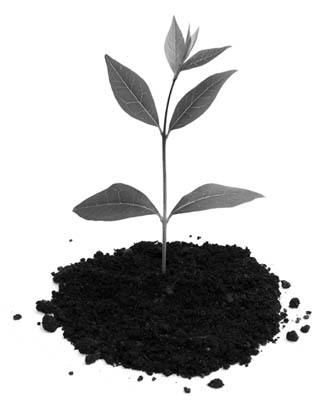Lovely Leftovers
Mulching Your Garden

At the risk of being boring, I’m bringing up a frequent topic of mine again-mulch. It is looking like a dry year, so water will be at a premium for a while. Mulching your garden can go a long way toward easing the water woes.
Almost anything can be spread on the ground to help conserve the moisture in the soil that can be lost through evaporation. The other main function of mulch is to smother weeds. Eliminating weeds in itself is a water-saving move. Remember that plants actually draw the water out of the soil with their roots and release it into the air through the marvelous process of transpiration. As each precious water molecule exits through the stomata (microscopic little “mouths” that breathe for the plant) of the leaves, another molecule is pulled into the plant from the soil below. Think of a straw in a glass of water; you suck from the top and the water in your glass enters at the bottom. Because water just likes to hold onto its neighboring molecules (called surface tension, but it works in many wonderful ways), it forms an unbroken column inside the tiny “straws” that form a plant’s water transport system. The process is limited by the amount of water available to the roots. If you maintain only the desirable plants in your garden, you are making more water for them when you pull or smother the competing weeds.
Organic mulches are favored for one reason: They keep a huge amount of “waste” out of the landfill. All those lawn clippings, hedge trimmings, and deadheaded roses that many gardeners don’t recycle on their own are now diverted from the waste stream, collected, and turned into useful products, including mulch. The great thing about organic mulches is they also feed the soil organisms that feed your plants. In the great cycle of life that evolved long before we humans entered the stage, this recycling of dead and dying plants happened naturally. Our penchant for planting the wrong plant in the wrong place and then hacking off the offending bits and tossing them in the trash has finally led to a thriving industry in salvaging this valuable resource. All that green “waste” can be ground up, composted (even ever-so-briefly works just fine), and used to produce other finished products like potting soil or used as is to cover the soil.
Other organic materials like straw can also be used. Straw is great for spreading around crops like strawberries because the top layer dries quickly and keeps the fruit from sitting in the damp-an open invitation to some opportunistic fungus. Wood chips are perfect for use around most woody plants, from ornamental conifers to fruit trees. Should you find a ready source of such agricultural byproducts as rice hulls, coconut fiber, cocoa bean hulls, or pomace (leftover skins and seeds) from wineries, you can use them all, either directly or by composting for later use.
Organic is not the only way to go. Sometimes, a nice top-dressing of decorative stone can be what’s called for in a design. Shale, slate chips, lava clinkers, and glass slag are just a few that have found their way into the garden of late. These mineral mulches provide all the same functions of water retention and weed suppression as an organic mulch, and some can even aid in helping to retain heat in the soil as well. They don’t contribute to the soil food web, but there are some ways to circumvent that in the use of compost teas. These concentrated concoctions contain millions of microbes per ounce that will munch and be munched in the soil below the inactive mulch.
One practice usually not recommended unless you want to kill everything underneath (and sometimes you do) is the use of plastic films as mulch. It will surely suppress the weeds, but it will add nothing to the soil and will actually cut off the vital air and water that the soil organisms depend on. Use this only for hard cases of stubborn weeds or fungal pathogens that need to be eliminated before planting. Be sure to incorporate lots of living compost when you go to replant and then mulch heavily with an organic mulch to start the cycle again.
So if this really is a drought year, check your irrigation systems for efficiency, water only when the soil is dry, and mulch, mulch, mulch.



